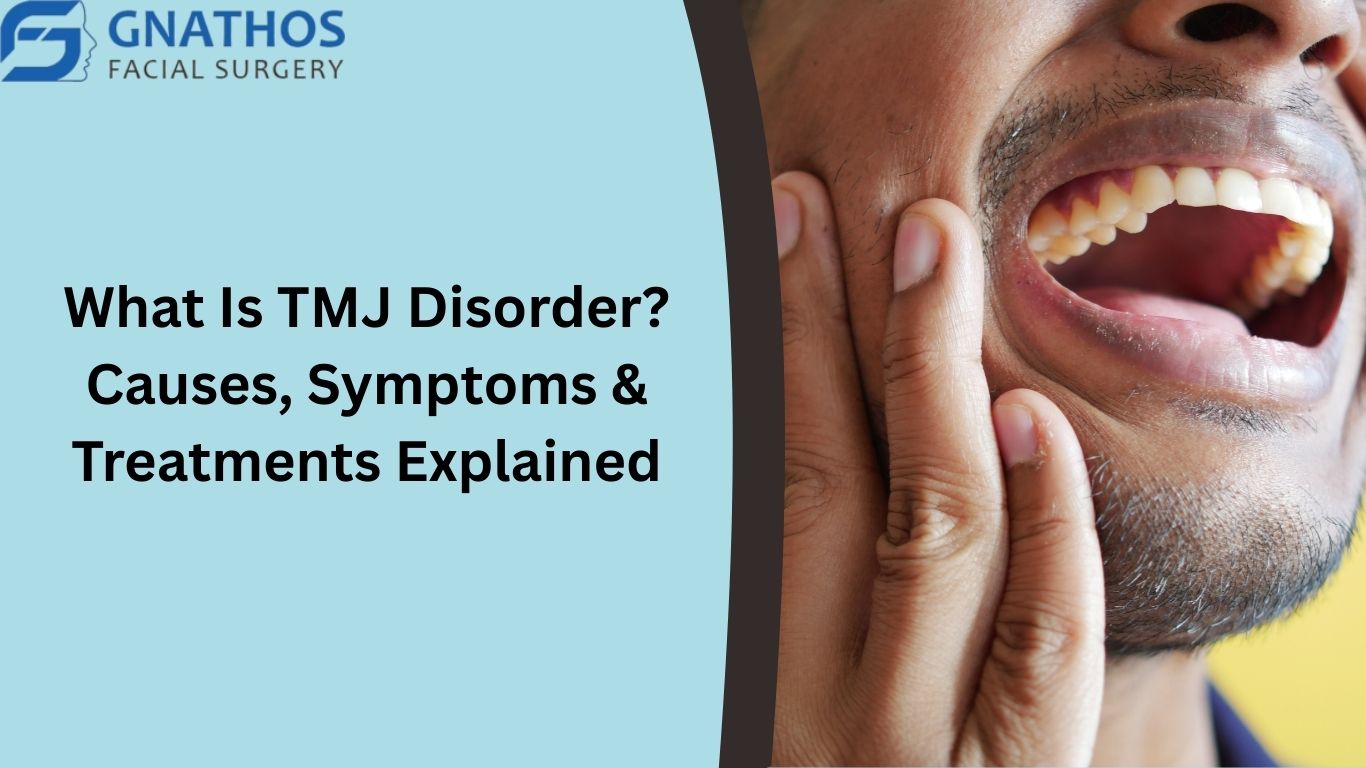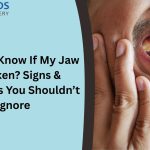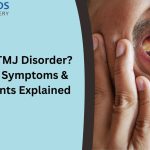You’ve probably been experiencing some strange sensations in your jaw – maybe a persistent ache, a bothersome click when you chew, or even a feeling like your jaw is getting stuck. These symptoms can be incredibly frustrating, interfering with everything from enjoying a meal to simply having a conversation. If you’ve looked online or talked to friends, you’ve likely come across the term “TMJ.” But what exactly is it? You’re not alone if you’re asking, “What is TMJ Disorder?“
It’s a really common question because, despite its prevalence, TMJ disorder (TMD for short) is often misunderstood. It’s not just one single problem, but rather a group of conditions that affect the temporomandibular joints (TMJs) – the complex hinges connecting your jaw to your skull – and the muscles and ligaments that control them. Today, we’re going to dive deep into answering “What is TMJ Disorder?” We’ll break down its various causes, explore the wide array of symptoms it can produce, and walk you through the effective treatment options available to help you find relief. Let’s unravel this mystery together!
Understanding the TMJ: The Star of the Show
Before we discuss the disorder, let’s appreciate the amazing joint itself. You have two temporomandibular joints (TMJs), one on each side of your head, located just in front of your ears. They are incredibly complex, acting like both a hinge and a sliding joint. This unique design allows your jaw to move in multiple directions: up and down for biting, side-to-side for grinding food, and forward and backward for actions like yawning.
Each TMJ consists of:
- The Condyle: The rounded end of your lower jawbone (mandible).
- The Temporal Bone: Part of your skull.
- An Articular Disc (Meniscus): A small, oval-shaped piece of cartilage nestled between the condyle and the temporal bone. This disc acts as a shock absorber, allowing smooth, friction-free movement of the jaw.
- Muscles and Ligaments: A complex network of muscles (like the masseter, temporalis, and pterygoids) control jaw movement, while ligaments provide stability to the joint.
When any of these components—the joint itself, the disc, or the surrounding muscles and ligaments—experience problems, that’s when you develop a Temporomandibular Disorder (TMD). So, “What is TMJ Disorder?” is essentially asking about a functional problem within this intricate system.
Suffering from Jaw Pain or Clicking Sounds?
TMJ Disorder can cause jaw pain, headaches, and difficulty chewing. Early diagnosis and personalized treatment can restore comfort and function.
Get Relief TodayWhat Are the Causes of TMJ Disorder? A Multifaceted Puzzle
The challenging thing about TMD is that its causes are often complex and can be multifactorial. It’s rarely just one single thing, which is why diagnosis can sometimes take time. Here are the most common culprits:
- Trauma or Injury:
- Direct Impact: A blow to the jaw, face, or head (e.g., from a fall, sports injury, or car accident) can directly damage the joint, disc, or surrounding muscles.
- Whiplash: Injuries that violently snap the head and neck can strain jaw muscles and ligaments.
- Microtrauma: Even seemingly minor, repetitive trauma, like constantly clenching your teeth, can contribute over time.
- Bruxism (Teeth Grinding or Clenching):
- This is a huge one. Many people unconsciously clench or grind their teeth, especially at night (sleep bruxism) or during stressful periods (awake bruxism). This puts immense, sustained pressure and strain on the TMJs and jaw muscles, leading to muscle fatigue, pain, and potentially joint damage or disc displacement over time.
- This is a huge one. Many people unconsciously clench or grind their teeth, especially at night (sleep bruxism) or during stressful periods (awake bruxism). This puts immense, sustained pressure and strain on the TMJs and jaw muscles, leading to muscle fatigue, pain, and potentially joint damage or disc displacement over time.
- Stress and Anxiety:
- There’s a strong mind-body connection here. Stress and anxiety often manifest physically, leading to muscle tension throughout the body, including the jaw, neck, and shoulders. This chronic muscle tension can directly cause or worsen TMD symptoms. Stress also frequently exacerbates bruxism.
- There’s a strong mind-body connection here. Stress and anxiety often manifest physically, leading to muscle tension throughout the body, including the jaw, neck, and shoulders. This chronic muscle tension can directly cause or worsen TMD symptoms. Stress also frequently exacerbates bruxism.
- Disc Displacement/Derangement:
- The articular disc within the TMJ can become displaced, meaning it slips out of its normal position. This can happen due to trauma, chronic strain, or sometimes for no clear reason.
- If the disc is displaced, it can interfere with smooth jaw movement, causing clicking, popping, grinding sounds, or even locking of the jaw. When the disc doesn’t move correctly, it puts direct stress on the joint’s tissues.
- Arthritis:
- Just like other joints in the body, the TMJ can be affected by various forms of arthritis.
- Osteoarthritis: Wear and tear of the joint cartilage, often due to aging or chronic stress on the joint.
- Rheumatoid Arthritis: An autoimmune disease that can cause inflammation and damage in multiple joints, including the TMJ.
- Arthritis can lead to pain, stiffness, limited movement, and a grating sound (crepitus) in the joint.
- Malocclusion (Bad Bite):
- While controversial as a primary cause, a significant misaligned bite (where upper and lower teeth don’t meet correctly) can sometimes contribute to TMD symptoms. The jaw might constantly shift to find a comfortable bite position, leading to muscle strain and joint stress. However, many people with malocclusion never develop TMD, and many with TMD have a perfectly aligned bite.
- While controversial as a primary cause, a significant misaligned bite (where upper and lower teeth don’t meet correctly) can sometimes contribute to TMD symptoms. The jaw might constantly shift to find a comfortable bite position, leading to muscle strain and joint stress. However, many people with malocclusion never develop TMD, and many with TMD have a perfectly aligned bite.
- Jaw and Facial Muscle Problems:
- Often, the pain isn’t primarily from the joint itself but from the muscles surrounding it (myofascial pain). Muscle spasms, fatigue, or trigger points in these muscles can cause widespread pain in the jaw, face, head, and neck. This can be due to overuse, clenching, or stress.
- Often, the pain isn’t primarily from the joint itself but from the muscles surrounding it (myofascial pain). Muscle spasms, fatigue, or trigger points in these muscles can cause widespread pain in the jaw, face, head, and neck. This can be due to overuse, clenching, or stress.
- Other Contributing Factors:
- Connective Tissue Diseases: Conditions like Ehlers-Danlos syndrome can affect ligaments and joint stability.
- Infections: Although rare, infections in or around the joint can cause TMD symptoms.
- Tumors: Very rarely, growths in the joint area can cause pain and dysfunction.
- Genetic Predisposition: Some individuals may be genetically more prone to developing TMD.
Suffering from Jaw Pain or Clicking Sounds?
TMJ Disorder can cause jaw pain, headaches, and difficulty chewing. Early diagnosis and personalized treatment can restore comfort and function.
Get Relief TodayUnderstanding these varied causes is crucial when asking “What is TMJ Disorder?” because it helps explain why symptoms can be so diverse and why a proper diagnosis is key.
What Are the Symptoms of TMJ Disorder? A Wide Range of Discomfort
The symptoms of TMD can be incredibly varied and affect many areas of the head, face, and neck, making it often difficult to diagnose without expert help. Here are the most common signs:
- Jaw Pain or Tenderness:
- This is the hallmark symptom. The pain can be dull and constant or sharp and stabbing. It’s often felt in the jaw joint itself (just in front of your ear), in the jaw muscles (cheeks, temples), or radiating into the neck and shoulders.
- It might be worse when you chew, talk, yawn, or open your mouth wide.
- Clicking, Popping, or Grating Sounds:
- Many people with TMD hear sounds when they open or close their mouth.
- Clicking/Popping: Often indicates that the articular disc is moving in and out of its correct position within the joint. A click on opening and a click on closing is common. It might not be painful initially, but can become so over time.
- Grating/Grinding (Crepitus): This usually suggests more significant joint degeneration, like roughening of the joint surfaces or advanced arthritis.
- Limited Jaw Movement or “Locking”:
- Limited Opening: You might find it difficult or painful to open your mouth as wide as you used to.
- Jaw Locking: Your jaw might temporarily get stuck in an open or closed position, making it impossible to move until it “unlocks.” This can be frightening and very painful.
- Facial Pain:
- Pain can spread throughout your face, not just the jaw. This can be felt in the cheeks, temples, or around the eyes.
- Pain can spread throughout your face, not just the jaw. This can be felt in the cheeks, temples, or around the eyes.
- Headaches:
- Often described as tension headaches, felt in the temples, forehead, or back of the head. TMJ-related headaches can be quite severe and mimic migraines.
- Often described as tension headaches, felt in the temples, forehead, or back of the head. TMJ-related headaches can be quite severe and mimic migraines.
- Ear Symptoms:
- Due to the close proximity of the TMJ to the ear canal, TMD can cause earaches, fullness in the ear, ringing in the ears (tinnitus), or even muffled hearing. These symptoms can be very confusing, often leading people to see an ENT first.
- Due to the close proximity of the TMJ to the ear canal, TMD can cause earaches, fullness in the ear, ringing in the ears (tinnitus), or even muffled hearing. These symptoms can be very confusing, often leading people to see an ENT first.
- Pain in the Neck and Shoulders:
- Chronic jaw muscle tension can radiate down into the neck and shoulders, leading to stiffness and pain in these areas.
- Chronic jaw muscle tension can radiate down into the neck and shoulders, leading to stiffness and pain in these areas.
- Changes in Bite:
- You might feel like your teeth don’t fit together correctly anymore, or that your bite feels “off.” This can be due to changes in joint position or muscle spasms.
- You might feel like your teeth don’t fit together correctly anymore, or that your bite feels “off.” This can be due to changes in joint position or muscle spasms.
- Dizziness:
- While less common, some individuals with TMD report feeling dizzy or experiencing vertigo-like sensations.
- While less common, some individuals with TMD report feeling dizzy or experiencing vertigo-like sensations.
- Swelling on the Side of the Face:
- Sometimes, there might be slight swelling on the side of the face where the painful TMJ is located.
Suffering from Jaw Pain or Clicking Sounds?
TMJ Disorder can cause jaw pain, headaches, and difficulty chewing. Early diagnosis and personalized treatment can restore comfort and function.
Get Relief TodayDiagnosing TMJ Disorder: Getting to the Bottom of It
Because the symptoms are so varied and can overlap with other conditions, accurately diagnosing TMD requires a thorough evaluation by a qualified healthcare professional. This process typically involves:
- Detailed Medical and Dental History: Your doctor will ask extensively about your symptoms, when they started, what makes them better or worse, any trauma, stress levels, and your overall health.
- Clinical Examination:
- Palpation: The doctor will gently feel your jaw muscles and joints to check for tenderness, spasms, or swelling.
- Auscultation: They will listen for clicking, popping, or grating sounds as you open and close your mouth.
- Range of Motion: They will measure how wide you can open your mouth and observe any deviations in jaw movement.
- Bite Assessment: They will examine how your upper and lower teeth come together.
- Imaging Studies:
- Panoramic X-ray: Provides a general view of your jaws and teeth.
- CT Scan (Computed Tomography): Excellent for visualizing the bone structure of the TMJ, identifying arthritis, fractures, or developmental issues.
- MRI (Magnetic Resonance Imaging): This is often the gold standard for visualizing the soft tissues of the TMJ, especially the articular disc. It can show if the disc is displaced, damaged, or inflamed.
- Other Imaging: Occasionally, specialized TMJ X-rays or a bone scan might be used.
Who Treats TMJ Disorder? Finding the Right Expert
Given the complexity of What is TMJ Disorder?, its treatment often involves a team approach. Here’s who you might see:
- General Dentist: Your first point of contact. They can often diagnose and manage mild cases, particularly those related to teeth grinding, and provide a referral to a specialist.
- Oral and Maxillofacial Surgeon (OMS): This is often the most comprehensive specialist for TMD, especially for complex cases, those involving joint structural problems (like disc displacement or arthritis), or when conservative treatments fail. They are skilled in both non-surgical and surgical interventions.
- Orofacial Pain Specialist: A dentist with advanced training specifically in diagnosing and managing chronic pain conditions of the head, face, and neck, including TMD. They often focus on non-surgical approaches.
- Physical Therapist: A specialized physical therapist can help with jaw exercises, manual therapy, posture correction, and pain management techniques.
- Neurologist: If headaches or nerve pain are prominent and complex.
- Rheumatologist: If an autoimmune condition like rheumatoid arthritis is suspected.
- Psychologist/Counselor: To address stress, anxiety, or behavioral habits (like clenching) that contribute to TMD.
Suffering from Jaw Pain or Clicking Sounds?
TMJ Disorder can cause jaw pain, headaches, and difficulty chewing. Early diagnosis and personalized treatment can restore comfort and function.
Get Relief TodayTreatment Options for TMJ Disorder: A Path to Relief
The good news is that most TMD cases respond well to conservative, non-surgical treatments. Surgery is typically reserved for severe cases with clear structural damage that doesn’t respond to other therapies.
Conservative Treatments (First Line of Defense):
- Self-Care Measures:
- Soft Diet: Avoid hard, chewy, or crunchy foods.
- Avoid Extreme Jaw Movements: Limit wide yawning, excessive chewing gum, or clenching.
- Heat/Cold Therapy: Apply moist heat or ice packs to the jaw and temples.
- Stress Management: Practice relaxation techniques (meditation, yoga, deep breathing) to reduce muscle tension.
- Medications:
- Pain Relievers: Over-the-counter NSAIDs (ibuprofen, naproxen) or prescription pain medications.
- Muscle Relaxants: To alleviate muscle spasms and tension.
- Low-Dose Tricyclic Antidepressants: Can help with pain control, improve sleep, and reduce teeth grinding, even in non-depressed individuals.
- Oral Appliances (Splints/Night Guards):
- These are custom-made acrylic devices worn over the teeth (usually at night). They can help reduce clenching and grinding, protect teeth, and sometimes help reposition the jaw or disc.
- Physical Therapy:
- Specific jaw exercises, stretching, manual therapy, posture correction, and modalities like ultrasound or TENS.
- Trigger Point Injections: Injecting local anesthetic or steroids into painful muscle knots.
Suffering from Jaw Pain or Clicking Sounds?
TMJ Disorder can cause jaw pain, headaches, and difficulty chewing. Early diagnosis and personalized treatment can restore comfort and function.
Get Relief TodayMinimally Invasive Procedures (When Conservative Fails):
- Arthrocentesis: A procedure where fluid is injected into the joint to wash out inflammatory byproducts, lubricate the joint, and sometimes free a stuck disc.
- Arthroscopy: A minimally invasive surgery where a tiny camera (arthroscope) is inserted into the joint. It allows the surgeon to visualize the joint’s interior, remove adhesions, flush the joint, and sometimes reposition the disc.
Surgical Interventions (Last Resort for Severe Cases):
- Open-Joint Surgery: For severe structural problems, such as extensive disc damage, joint degeneration, or tumors. This is a major surgery with a significant recovery period.
- Total Joint Replacement: In rare, severe cases where the TMJ is irreversibly damaged, the joint may be replaced with a prosthetic one.
Living with TMD and Finding Your Path to Relief
Understanding “What is TMJ Disorder?” is the first step toward managing your symptoms and finding lasting relief. It’s a journey that often requires patience, consistency, and a collaborative approach with your healthcare team. Don’t get discouraged if the first treatment doesn’t work perfectly; there are many options, and your doctor will help you find the right combination.
For comprehensive evaluation and personalized treatment of your TMJ disorder, it’s invaluable to consult with a specialist who possesses deep expertise in the complex mechanics of the jaw and face. Professionals like Dr. Suresh are highly skilled in diagnosing the nuances of TMD and offering a range of effective solutions, from conservative management to advanced surgical interventions when necessary. To explore how Dr. Suresh can help you achieve relief from your TMJ discomfort and improve your jaw health, you can visit https://gnathosface.com/. Remember, getting an accurate diagnosis and a tailored treatment plan from an experienced professional like Dr. Suresh is crucial for your comfort and long-term well-being.
Suffering from Jaw Pain or Clicking Sounds?
TMJ Disorder can cause jaw pain, headaches, and difficulty chewing. Early diagnosis and personalized treatment can restore comfort and function.
Get Relief TodayFrequently Asked Questions (FAQs)
Is TMJ the same as TMD?
No, “TMJ” refers to the temporomandibular joint itself, the actual joint connecting your jaw to your skull. “TMD” stands for Temporomandibular Disorder, which is the broader term for a group of conditions that cause pain and dysfunction in the jaw joint and the muscles that control jaw movement. So, you can have a TMJ, but you develop a TMD.
What are the most common symptoms of TMJ disorder?
The most common symptoms of TMJ disorder include pain or tenderness in the jaw joint area, facial pain, headaches, clicking, popping, or grating sounds when opening or closing your mouth, and difficulty or pain when chewing, yawning, or opening your mouth wide. Some individuals may also experience jaw locking or a feeling that their bite is off.
Can stress cause TMJ disorder?
While stress doesn’t directly cause a physical defect in the TMJ, it is a significant contributing factor to TMJ disorder symptoms. Stress often leads to increased muscle tension, teeth clenching (bruxism), and grinding, all of which put immense strain on the jaw muscles and joints, exacerbating or even initiating TMD symptoms.
What is the first line of treatment for TMJ disorder?
The first line of treatment for TMJ disorder is typically conservative and non-surgical. This often includes self-care measures like eating a soft diet and avoiding extreme jaw movements, along with over-the-counter pain relievers, stress management techniques, and the use of oral appliances like custom-made night guards to prevent clenching and grinding.
When is surgery considered for TMJ disorder?
Surgery for TMJ disorder is generally considered a last resort and is reserved for severe cases where there is clear structural damage to the joint (like severe disc displacement, advanced arthritis, or ankylosis) that has not responded to extensive conservative and less invasive treatments. The type of surgery can range from minimally invasive procedures to open-joint surgery or even total joint replacement in rare situations.
Who is the best type of doctor to see for TMJ disorder?
While your general dentist can provide an initial assessment and manage mild cases, for more complex or persistent TMJ disorder, the most comprehensive specialist to see is often an Oral and Maxillofacial Surgeon. They possess extensive training in both dentistry and medicine, allowing them to diagnose and treat the full spectrum of TMDs, including both non-surgical and, if necessary, surgical interventions. Orofacial Pain Specialists are also highly trained in non-surgical pain management for TMD.












